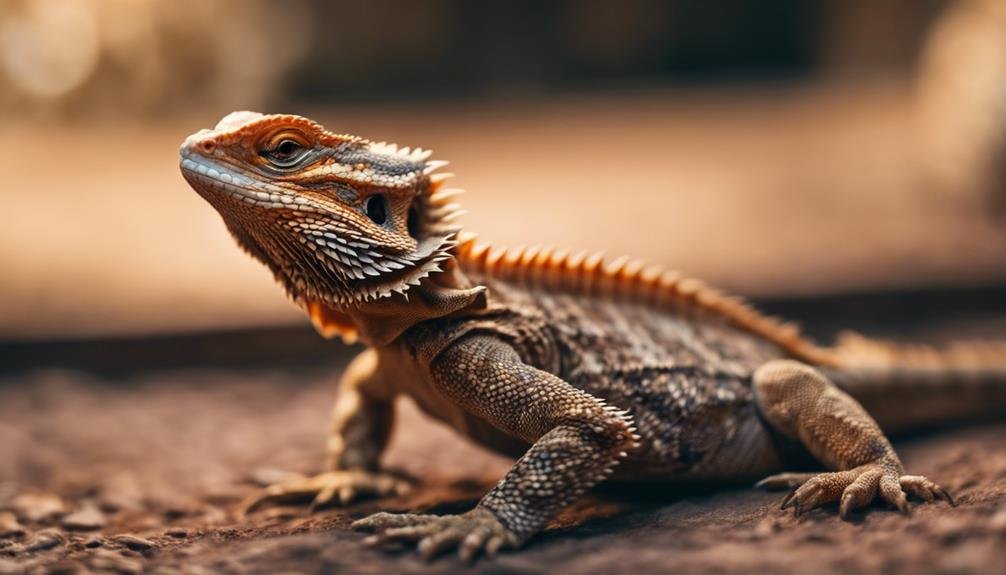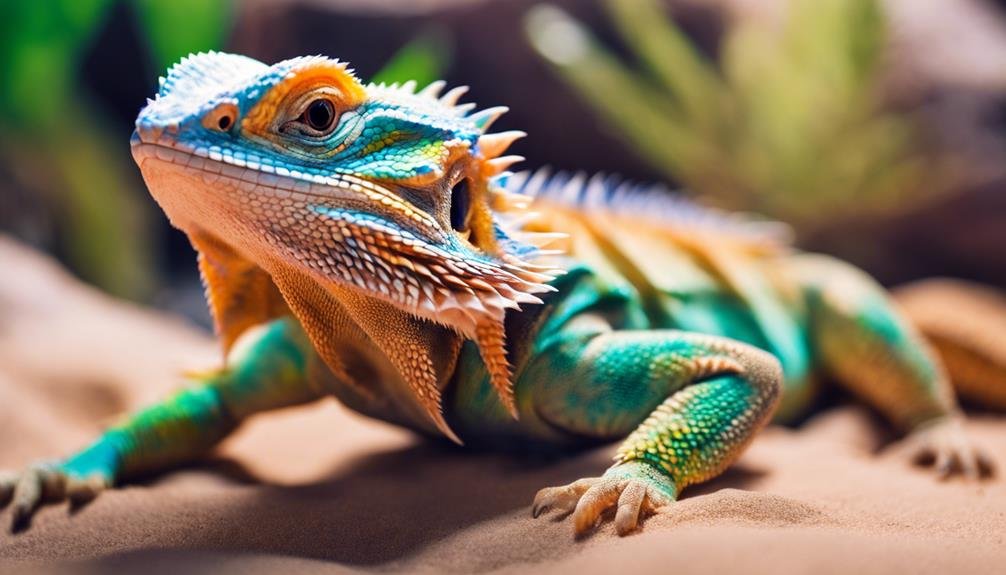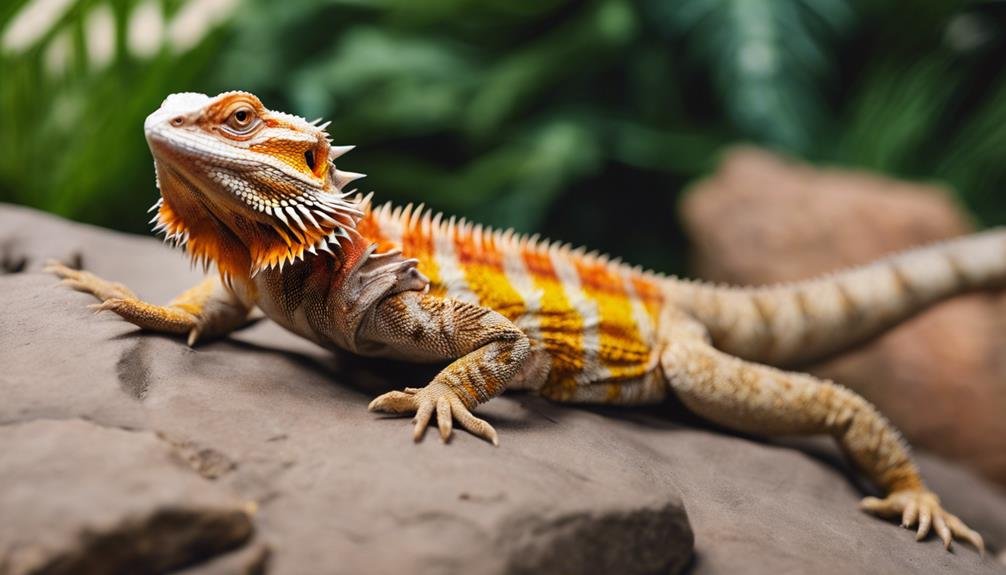When you explore the intriguing world of bearded dragon morphs, you encounter a spectrum of colors, patterns, and textures that make each one unique. From the classic morphs with their vibrant hues to specialized types like leatherbacks and silkbacks, there’s much to ponder, especially if you’re considering breeding. You’ll find that each morph looks different and has specific care requirements, making your choice more than just an aesthetic one. Are you curious about the genetic intricacies and the special care some morphs demand? Let’s look closer at how these fascinating traits come to life.
Key Takeaways
- Classic morphs are budget-friendly with vibrant colors and well-defined scales, ideal for novice keepers.
- Leatherback variants have smooth backs and vivid colors, which are popular among breeders due to their unique appearance.
- Hypomelanistic types feature pastel colors and clear nails, making them favorites of both new and experienced reptile owners.
- Translucent varieties have almost see-through scales and dark eyes, adding to their intricate and unique texture.
- Silkback morphs lack protective scales, requiring specialized care and a controlled environment to prevent injuries.
Classic Morphs


Like their wild counterparts, classic morphs are the most common and budget-friendly bearded dragons. Their traditional appearance makes them a popular choice among enthusiasts. When you look at a classic morph, you’ll notice their small spikes and large triangular heads, which add to their distinctive look. The scales of these dragons are prominent and well-defined, giving them that iconic, rugged texture.
Colors are another standout feature of classic morphs. You’ll find them in vibrant colors, including tan, red, yellow, black, and orange. These natural hues give them an earthy yet strikingly beautiful appearance. The combination of these colors and their traditional features make them highly appealing to novice and experienced reptile owners.
Classic morphs aren’t just about looks. Their affordability makes them accessible for anyone interested in owning a bearded dragon without breaking the bank. Despite their lower cost, they still provide the same enjoyment and companionship as more expensive morphs.
Leatherback Variants
Leatherback bearded dragons, known for their smooth backs and vivid colors, offer a unique and striking alternative to traditional morphs. Unlike standard morphs, Leatherbacks lack the typical spikes on their backs, though they maintain some spikes on their heads and sides. This absence of spikes allows their vibrant colors and intricate patterns to shine more distinctly, making them a favorite among breeders and collectors.
The smooth back of Leatherbacks provides a clearer canvas for their colors and patterns, resulting in a more vivid and eye-catching appearance. Whether you’re a breeder looking to diversify your offerings or a collector seeking a standout specimen, Leatherbacks will impress.
Here’s a quick comparison to highlight the unique features of Leatherbacks:
| Feature | Leatherbacks |
|---|---|
| Back Texture | Smooth back |
| Spike Presence | Only on the head and sides |
| Color Display | Enhanced due to the absence of spikes |
| Popularity | High among breeders and collectors |
| Unique Traits | Vivid colors, clear patterns, and unique appearance |
Leatherbacks are less common than standard morphs but are highly sought after for their distinct look. Their smooth backs and vibrant colors make them stand out, offering a visually appealing and unique addition to any bearded dragon collection.
Hypomelanistic Types


While Leatherbacks captivate with their smooth backs and vibrant colors, Hypomelanistic bearded dragons offer a more subdued yet equally fascinating palette. These dragons, often called ‘hypo’ dragons, showcase a pastel coloration with muted colors, giving them a lighter appearance that stands out in its own right. What makes them particularly unique is their inability to produce dark patterns, resulting in a softer color palette that many enthusiasts find appealing.
Hypomelanistic bearded dragons are easily recognizable by their clear nails and spike body type. These physical traits add to their charm, making them a popular choice for new and experienced keepers. If you’re considering adding a hypo dragon to your collection, here are three key characteristics to keep in mind:
- Pastel Coloration: Expect a range of soft, muted colors that create a unique color palette.
- Clear Nails: Unlike other morphs, hypo dragons have almost see-through nails.
- Spike Body Type: They maintain the classic bearded dragon spikes, adding to their distinctive look.
Hypo dragons are fairly common in the bearded dragon community, making them an accessible and delightful option for any reptile lover.
Translucent Varieties
Translucent bearded dragons captivate enthusiasts with their almost see-through spikes and scales, creating a unique and ethereal appearance. These dragons belong to a morph known for their translucent qualities, including hypomelanistic coloration. This means they typically appear lighter in color compared to standard morphs, giving them a subtle, muted color palette that’s distinctively charming.
One of the unique characteristics of translucent bearded dragons is their clear nails, which add to their delicate and almost otherworldly look. These dragons often display a striking blue belly when they’re young, although this feature usually fades as they mature. However, their solid dark eyes and blue eyelids remain, lending them a distinctive and somewhat mystical appearance throughout their life.
The translucent morph stands out not just for its color but also for its pattern and texture. The almost see-through scales and spikes create an intricate, mesmerizing pattern to observe up close. For bearded dragon enthusiasts, the translucent varieties offer a fascinating blend of beauty and uniqueness, making them a highly sought-after morph in the reptile community.
Silkback Morphs


Silkback morphs are fascinating due to their smooth skin and vibrant colors, but they require special care because they lack protective scales.
You’ll find that their unique physical characteristics make them stand out among other bearded dragons.
When breeding silkbacks, it’s essential to understand their specific needs to guarantee their well-being.
Unique Physical Characteristics
Silkback morphs stand out among bearded dragon morphs for their smooth, spike-free skin and vibrant colors. Their lack of spikes and protective scales gives them a unique physical characteristic that differentiates them from other morphs. This smooth skin contributes to their distinct appearance and makes their colors more vibrant and eye-catching.
However, the absence of scales makes silkback morphs more susceptible to injuries. Their soft skin texture requires you to handle them extra care to prevent damage. This vulnerability makes silkbacks more challenging to care for than other bearded dragon morphs.
Here’s what makes silk back morphs truly unique:
- Smooth Skin: Unlike other bearded dragons, silkbacks lack spikes and protective scales, giving them an exceptionally smooth skin texture.
- Vibrant Colors: The absence of scales makes their colors appear more vibrant and striking.
- Susceptibility to Injuries: Silkbacks are more prone to injuries and require special care without the protective outer layer.
Specialized Care Requirements
Given their unique physical characteristics, caring for silkback morphs requires careful attention to their specialized needs. Because silkback morphs lack protective scales, they’re particularly vulnerable to injuries like scratches, abrasions, and burns. Their smooth skin demands a controlled environment to guarantee their safety.
Maintaining proper humidity levels is vital to prevent dehydration, as bearded dragons’ skin can dry out more quickly than other morphs. Regular moisturizing is essential to keeping their skin healthy. Using a reptile-safe moisturizer can help maintain their smooth skin and avoid issues related to dryness.
Gentle handling is another significant aspect of their care. Avoid rough surfaces and be cautious during interactions to prevent accidental harm. Additionally, their diet might need adjustments to compensate for their lack of protective scales. Providing a diet higher in vitamins and supplements can help support their overall health.
Silkback morphs benefit from the extra nutrients these diets offer, aiding their resilience and well-being. Consistent monitoring and adjustments to their care routine will ensure your silkback morph thrives in its environment. You can provide a safe and nurturing home for your unique pet by addressing these special care requirements.
Breeding Silkback Morphs
Breeding silkback morphs involves pairing two dragons with the scaleless trait to produce smooth-skinned offspring. These unique bearded dragons have vibrant colors and a striking appearance due to their lack of scales. However, breeding silkback morphs isn’t without its challenges. You’ll need to consider several factors to guarantee healthy, scaleless offspring.
First, here’s what to bear in mind:
- Genetics Consideration: Make sure both parent dragons carry the scaleless trait to guarantee the silkback morphs inherit it.
- Special Care: Silkback morphs lack protective scales, making them vulnerable to injuries. They require more attentive care than other morphs.
- Challenging to Care For: Their smooth skin needs regular moisturizing and protection from rough surfaces to prevent damage.
When you pair two silkback dragons, monitoring their health closely is crucial. Their unique appearance comes with a responsibility to provide a safe and nurturing environment.
Due to their lack of scales, silkback morphs are prone to skin issues and need a habitat free from abrasive materials. Proper lighting, temperature, and diet are vital to maintaining well-being.
Unique Morphs
You’ll encounter fascinating varieties like the Silkback, German Giant, Dunner, Zero, and Witblits when exploring unique bearded dragon morphs. Each morph offers distinct characteristics that make it stand out.
Silkbacks, for example, lack protective scales, giving them a smooth appearance but requiring special care to prevent injuries. Bearded dragon breeders often find Silkbacks intriguing due to their notable size and the extra care they demand.
German Giant morphs are remarkable for their substantially larger size, often requiring more spacious enclosures. Their impressive stature makes them a favorite among enthusiasts looking for something grand.
The Dunner morph is another unique variant, characterized by scale markings that run in different directions, creating a chaotic yet fascinating pattern.
Zero morphs are rare and stand out for their lack of patterns and colors, appearing almost entirely white. This rare coloration makes them highly sought after.
Similarly, Witblits morphs lack patterns but are pale in color, offering a striking and unique appearance compared to other morphs.
These unique morphs add diversity to the world of bearded dragons and challenge breeders to meet their distinct care needs.
Conclusion
Exploring bearded dragon morphs offers a captivating journey into the world of these mesmerizing reptiles. Whether you’re drawn to classic morphs, intrigued by leatherbacks, or excited by the unique traits of hypomelanistics, translucents, and silkbacks, there’s always something new to discover.
Remember, each morph has its own care needs and personality quirks. So, delve into the adventure of finding the perfect bearded dragon!
FAQs
1. What Is the Rarest Bearded Dragon Morph?
The rarest morph, characterized by genetic rarity and unique color mutations, is the Zero morph. Through selective breeding, it lacks usual morph definitions, unique patterns, hypo morphs, tiger stripes, leatherback traits, translucent scales, and silkback characteristics.
2. How Do I Tell What Morph My Bearded Dragon Is?
To identify your dragon’s morph, observe its color variations, scale patterns, eye color, head shape, tail length, beard hue, and skin texture. Compare these traits to breeding traits and genetic markers. Size differences can also help.
3. How Much Is a Fancy Bearded Dragon?
When considering buying a fancy bearded dragon, factor in breeding costs, morph prices, and initial investment for habitat setup. Pet stores and online marketplaces vary. Don’t forget diet requirements, vet care, lifespan expectations, and handling tips.
4. What Is a Citrus Bearded Dragon?
A citrus bearded dragon features a lemon color, achieved through selective breeding. They have specific diet needs and habitat requirements. Their growth patterns, behavioral traits, skin texture, shedding habits, common ailments, and tank mates are also unique.

